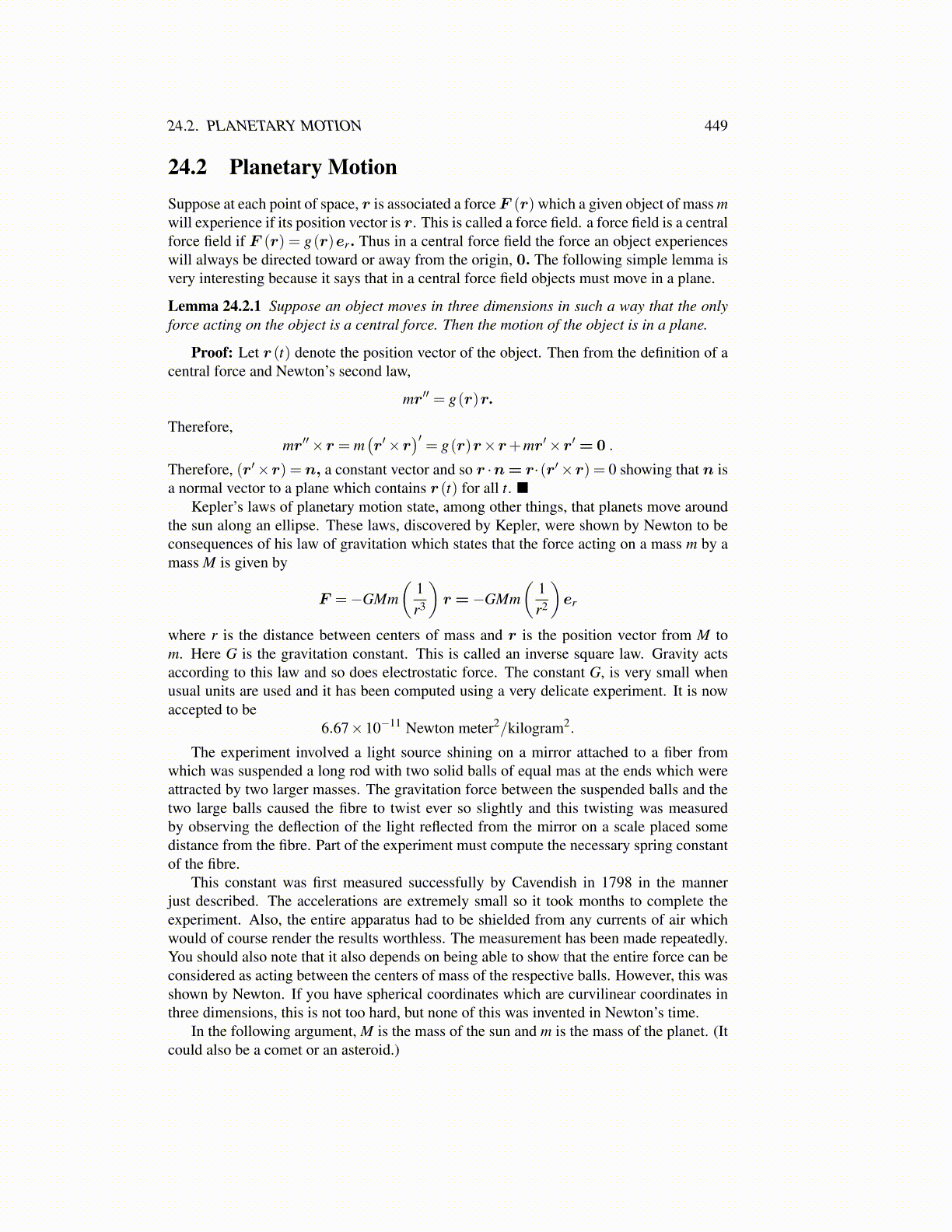
24.2. PLANETARY MOTION 449
24.2 Planetary MotionSuppose at each point of space, r is associated a force F (r) which a given object of mass mwill experience if its position vector is r. This is called a force field. a force field is a centralforce field if F (r) = g(r)er. Thus in a central force field the force an object experienceswill always be directed toward or away from the origin, 0. The following simple lemma isvery interesting because it says that in a central force field objects must move in a plane.
Lemma 24.2.1 Suppose an object moves in three dimensions in such a way that the onlyforce acting on the object is a central force. Then the motion of the object is in a plane.
Proof: Let r (t) denote the position vector of the object. Then from the definition of acentral force and Newton’s second law,
mr′′ = g(r)r.
Therefore,mr′′×r = m
(r′×r
)′= g(r)r×r+mr′×r′ = 0 .
Therefore, (r′×r) =n, a constant vector and so r ·n= r·(r′×r) = 0 showing that n isa normal vector to a plane which contains r (t) for all t. ■
Kepler’s laws of planetary motion state, among other things, that planets move aroundthe sun along an ellipse. These laws, discovered by Kepler, were shown by Newton to beconsequences of his law of gravitation which states that the force acting on a mass m by amass M is given by
F =−GMm(
1r3
)r =−GMm
(1r2
)er
where r is the distance between centers of mass and r is the position vector from M tom. Here G is the gravitation constant. This is called an inverse square law. Gravity actsaccording to this law and so does electrostatic force. The constant G, is very small whenusual units are used and it has been computed using a very delicate experiment. It is nowaccepted to be
6.67×10−11 Newton meter2/kilogram2.
The experiment involved a light source shining on a mirror attached to a fiber fromwhich was suspended a long rod with two solid balls of equal mas at the ends which wereattracted by two larger masses. The gravitation force between the suspended balls and thetwo large balls caused the fibre to twist ever so slightly and this twisting was measuredby observing the deflection of the light reflected from the mirror on a scale placed somedistance from the fibre. Part of the experiment must compute the necessary spring constantof the fibre.
This constant was first measured successfully by Cavendish in 1798 in the mannerjust described. The accelerations are extremely small so it took months to complete theexperiment. Also, the entire apparatus had to be shielded from any currents of air whichwould of course render the results worthless. The measurement has been made repeatedly.You should also note that it also depends on being able to show that the entire force can beconsidered as acting between the centers of mass of the respective balls. However, this wasshown by Newton. If you have spherical coordinates which are curvilinear coordinates inthree dimensions, this is not too hard, but none of this was invented in Newton’s time.
In the following argument, M is the mass of the sun and m is the mass of the planet. (Itcould also be a comet or an asteroid.)